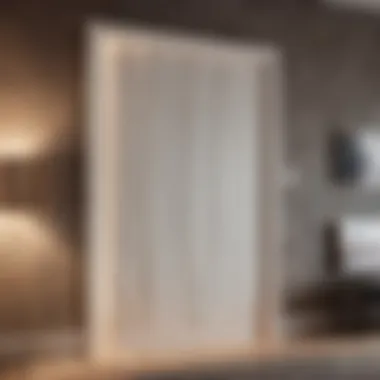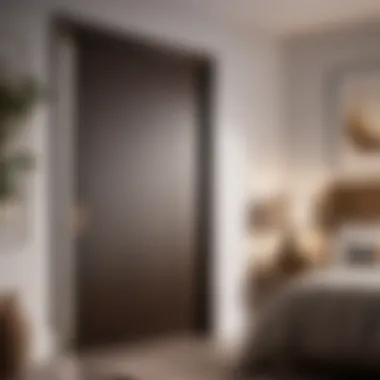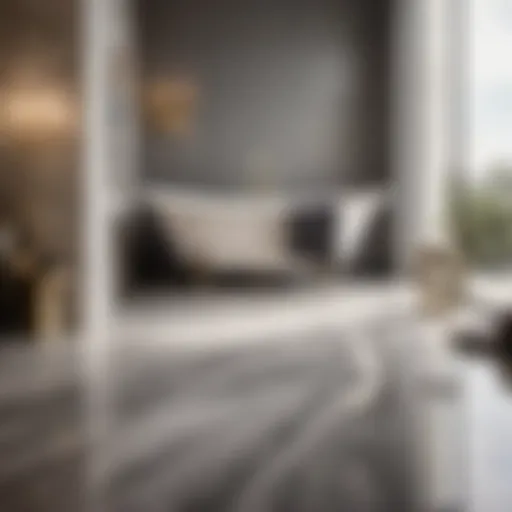Unlocking Peace: The Ultimate Guide to Soundproofing a Bedroom Door


Materials:
- Acoustic foam panels (Quantity: 6 panels, Size: 12x12 inches)
- Green Glue compound (Amount: 1 gallon)
- Caulk Gun
- Soundproofing door sweep
- Screwdriver
- Weatherstripping tape
- Drill
- Soundproofing curtains
DIY Steps:
- Assess Noise Sources: Identify gaps around the door, air vents, and gaps in the door frame.
- Apply Weatherstripping Tape: Seal gaps with weatherstripping tape to prevent sound leakage.
- Install Soundproofing Door Sweep: Attach the door sweep to the bottom of the door to block sound from passing through.
- Add Acoustic Foam Panels: Apply Green Glue on the back of the foam panels and stick them on the door to absorb sound waves.
- Use Soundproofing Curtains: Hang soundproofing curtains to enhance sound absorption.
Technical Aspects:
- Tools: Caulk gun, screwdriver, drill
- Timing: Plan for a full day to complete the soundproofing project
- Critical Techniques: Proper application of Green Glue, precise installation of door sweep
DIY Project Process:
- Start by assessing the areas causing noise leakage, focusing on the door and its surroundings.
- Apply weatherstripping tape to seal any gaps around the door frame to prevent sound from seeping through.
- Install the soundproofing door sweep at the bottom of the door, ensuring a tight seal.
- Use Green Glue to attach acoustic foam panels to the door surface, covering as much area as possible for sound absorption.
- Hang soundproofing curtains to further enhance the soundproofing effect.
Troubleshooting Tips:
- If the door sweep is not sealing tightly, adjust the positioning and ensure a snug fit.
- If air vents are causing noise leakage, consider installing soundproofing covers.
This comprehensive guide details the materials, steps, technical aspects, and troubleshooting tips required to effectively soundproof a bedroom door. By following these detailed instructions, housewives and homeowners can create a peaceful and quiet environment within their living space, enhancing overall comfort and tranquility.


Understanding Soundproofing
Importance of Soundproofing
The importance of soundproofing cannot be overstated when aiming to create a tranquil living environment. By minimizing the impact of external noises, individuals can enjoy a sense of calm and privacy in their abode. Soundproofing a bedroom door specifically offers a sanctuary for relaxation and undisturbed rest, which is essential for overall mental and emotional well-being. Investing in soundproofing solutions not only enhances indoor acoustics but also boosts property value and overall comfort within the living space.
Factors Affecting Sound Transmission
Several factors influence sound transmission through a bedroom door, including the door's material, thickness, and sealing quality. The solidness of the door plays a significant role in blocking sound waves, with denser materials like solid wood being more effective than hollow-core doors. The thickness of the door also plays a part, as thicker doors absorb and dampen sound vibrations better. Additionally, the presence of gaps, cracks, or poor insulation around the door frame can significantly impact sound transmission, allowing noise to seep through easily.
Types of Noise
Understanding the types of noise that affect soundproofing efforts is essential for selecting appropriate solutions. Airborne noise, such as voices or music, travels through the air and can be reduced by adding acoustic panels or soundproofing foam. Impact noise, like footsteps or banging, transmits through structural elements and requires methods like resilient channels or mass-loaded vinyl to minimize. Understanding these distinctions helps homeowners tailor their soundproofing approach to suit the specific noise challenges they face.
Assessment and Preparation
In the realm of soundproofing a bedroom door, the initial step of assessment and preparation plays a vital role in achieving the desired results of a peaceful and quiet living space. Before diving into the various soundproofing solutions, it is crucial to thoroughly assess the current situation and prepare adequately for the task ahead. This section serves as the foundation upon which the entire soundproofing process is built.
Assessment involves a meticulous examination of the factors contributing to noise transmission through the door. By identifying the primary sources of noise, such as external traffic, neighbors, or household appliances, homeowners can pinpoint the specific areas that require soundproofing interventions. This detailed analysis allows for a tailored approach to addressing the unique noise challenges faced in each living environment.
Furthermore, preparation encompasses gathering the necessary tools and materials needed for the soundproofing project. From measuring the door dimensions accurately to selecting the appropriate soundproofing solutions based on the assessment findings, this stage sets the groundwork for a successful soundproofing endeavor. Homeowners should also consider the time and budget allocated for the project, ensuring a smooth and efficient execution from start to finish.
By focusing on assessment and preparation in the soundproofing process, individuals can proactively tackle noise issues at the root level, leading to enhanced peace and tranquility within their living space.


Soundproofing Solutions
In this article, the discussion on Soundproofing Solutions plays a pivotal role in creating a tranquil environment within your bedroom. Understanding the significance of efficient soundproofing solutions is crucial for maintaining a peaceful living space. By addressing specific soundproofing techniques and materials, you can significantly reduce noise disturbances and enhance comfort levels within your home.
When exploring Soundproofing Solutions, it is imperative to consider various elements to ensure optimal effectiveness. Factors such as the type of noise present, the thickness of walls and doors, and the desired level of sound reduction all come into play. Additionally, the benefits of soundproofing solutions extend beyond noise reduction, encompassing improved privacy, enhanced focus, and a heightened sense of relaxation.
Moreover, considerations about Soundproofing Solutions should involve evaluating the cost-effectiveness of different methods, the level of expertise required for installation, and the long-term durability of chosen materials. By carefully weighing these factors, you can make informed decisions that align with your soundproofing goals and budget constraints.
Weather Stripping and Door Sweeps
Weather stripping and door sweeps are essential components of soundproofing a bedroom door effectively. Weather stripping seals the gaps between the door and the frame, preventing the passage of external noise into the room. This simple yet effective solution can make a substantial difference in reducing sound transmission.
When it comes to door sweeps, these devices act as barriers against sound leakage through the bottom of the door. By installing a door sweep, you create a tight seal that inhibits noise from entering or exiting the room. Furthermore, door sweeps help with temperature regulation and energy efficiency, making them a multifunctional addition to your soundproofing efforts.
Ensuring the proper installation of weather stripping and door sweeps is crucial for their effectiveness. Be meticulous in measuring and cutting the materials to fit your door accurately. Additionally, regular maintenance and replacement of worn-out weather stripping and door sweeps are necessary to uphold the soundproofing integrity of your bedroom door.
Soundproofing Foam Panels
Soundproofing foam panels are an excellent choice for dampening sound within a room. These panels are designed to absorb and minimize noise reflections, enhancing the acoustics of your space. By strategically placing soundproofing foam panels on the walls surrounding your bedroom door, you can reduce reverberations and create a quieter environment.
When considering soundproofing foam panels, it is essential to select high-quality materials that offer effective sound absorption properties. The thickness and density of the foam panels play a significant role in their soundproofing capabilities, so opt for panels that align with your specific noise reduction needs.null
*Note: Care should be taken not to overstuff the room with foam panels, as this may lead to a muffled or unnatural sound environment.


Advanced Techniques
In the realm of soundproofing a bedroom door, advanced techniques play a crucial role in achieving optimal noise reduction within a living space. By delving deeper into advanced methods, individuals can significantly elevate the soundproofing effectiveness of their doors. Embracing advanced techniques entails a more intricate and detailed approach, often involving a combination of strategies to create a robust sound barrier that effectively prevents noise from entering or escaping a room.
Building a Soundproofing Barrier
Building a soundproofing barrier is a pivotal advanced technique when enhancing the acoustical performance of a bedroom door. This technique involves constructing a layered barrier using specialized materials that absorb, block, and dampen sound waves. Key considerations include selecting high-quality soundproofing materials such as mass-loaded vinyl, acoustic foam, or soundproofing blankets to effectively combat different types of noise. Ensuring proper installation and sealing any gaps are essential steps for optimal soundproofing results.
Adding Soundproof Curtains
Integrating soundproof curtains presents an innovative solution for combating noise infiltration through a bedroom door. Soundproof curtains are designed with dense, noise-absorbing materials that help reduce the transmission of sound waves. When strategically placed near a door, soundproof curtains can effectively minimize noise intrusion, providing a quieter indoor environment. Consider factors such as thickness, material quality, and coverage area when selecting soundproof curtains to maximize their effectiveness in soundproofing a door.
Creating a Double Door System
Implementing a double door system is a sophisticated approach to soundproofing a bedroom door that offers enhanced noise reduction capabilities. By installing two doors with an air gap in between, the double door system forms a formidable barrier against sound transmission. This setup effectively traps sound waves and minimizes their ability to pass through, resulting in a quieter and more tranquil room ambiance. Take into account the space available, door size, and proper sealing to optimize the effectiveness of a double door system in soundproofing a bedroom.
Finishing Touches
In the quest for achieving a fully soundproof bedroom door, the final stage of 'Finishing Touches' plays a crucial role in ensuring the effectiveness of the soundproofing measures taken. This section focuses on the intricate details that can make a significant impact on the overall soundproofing outcome.
When it comes to soundproofing efforts, 'Finishing Touches' encompass the last steps taken to seal any remaining gaps and cracks around the door, ensuring that no sound can penetrate or escape from the room.
One of the key elements of 'Finishing Touches' is the meticulous sealing of gaps and cracks. Even small openings can compromise the soundproofing effectiveness of the door, allowing noise to enter or exit. By properly sealing these gaps, you can enhance the soundproofing capabilities of the door and create a more peaceful environment within the room.
Additionally, 'Finishing Touches' contribute to improving the energy efficiency of the door, as a well-sealed door helps in maintaining the desired temperature inside the room by preventing heat loss or gain. This not only enhances the soundproofing but also adds to the overall comfort and sustainability of the living space.
Another benefit of focusing on 'Finishing Touches' is the aesthetic enhancement it provides. By ensuring that gaps and cracks are carefully sealed with matching materials, you can achieve a polished look for the door, enhancing the overall appeal of the room.
When considering 'Finishing Touches,' it is essential to pay attention to the quality of materials used for sealing gaps and cracks. Opting for high-quality sealants and weather-stripping materials can make a significant difference in the longevity and effectiveness of the soundproofing solution.







